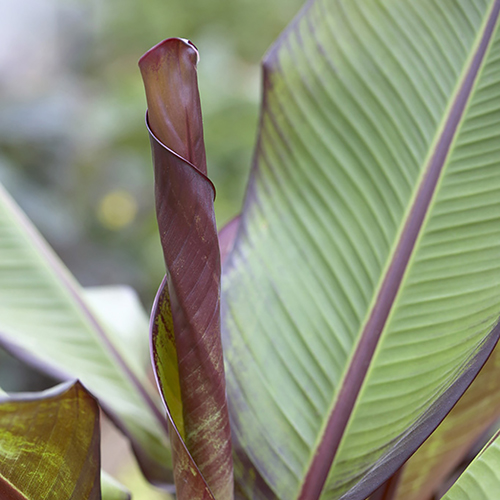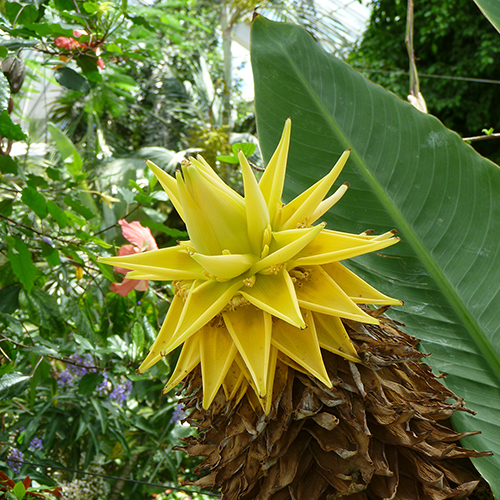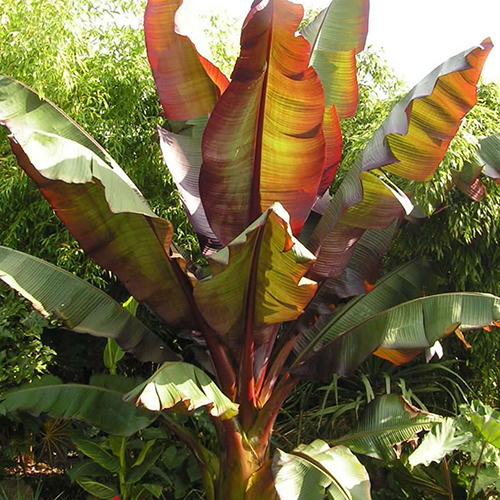The Jungle effect in our gardens can take our minds away to foreign climes and less stressful times in our lives when perhaps we have been on our holidays. The extremely architectural leaves of banana plants are ideal to create this effect. These plants are only enhanced by rainfall on the leaves like a tropical monsoon has occurred and they cast interesting shadows on the garden. They make a great focal point. They are very unlikely to produce any bananas in our climate, but the tropical effect of the leaves is almost unmatched. Here I wish to talk about three suitable varieties for our UK gardens.
Musa basjoo – Hardy banana
The huge fan-like leaves of this architectural banana create great impact where a tropical style garden is required. As the plant becomes established, the giant leaves will unfurl from the central trunk and they can reach over one metre long. This plant is native to Japan and so as you would expect it is a sun lover. It can be grown in a container to be moved to a frost free area in winter, or can be wrapped in the garden with fleece in the colder months as it is one of the hardier types and will stand temperatures down to -6C if given protection. when happy this plant can easily reach a stately height of thirteen feet (400cm). Small offsets at the base can be left to form a clump or separated to form new plants.
Musella lasiocarpa – Hardy Golden Lotus banana
This plant is reputed to be the hardiest of all the bananas we grow in the UK. Its giant, dramatic leaves give the perfect jungle effect. When mature long-lasting golden-yellow flowers are produced, hence the name Golden Lotus Banana. The plant can reach a height of four to five feet (120-150cm) and so is more manageable in the smaller garden than some and easily grown in a large container. It is said to stand temperatures well below freezing, due to its origins high up in the Chinese mountains of Yunnan. Unlike other bananas it forms a thick, sturdy trunk making it tougher. Even if leaves are damaged by frost and wind, new ones usually appear in the spring. Musella Lasiocarpa is monocarpic which means it dies after flowering. This however is not a huge concern as it grows like a clump-forming perennial and establishes new plants around the sides. It thrives in both sun or shade. It is easy to grow and will be the envy of the neighbours. To absolutely ensure survival, wrapping in fleece in harsh weather is recommended, or if grown in a container it can be moved to a frost free area.
Ensete ventricosum ‘Maurelii’ – Red Abysinnian Banana
The leaves of this Abysinnian Banana are perhaps the most colourful of all mentioned. The colour of the leaves and stems is enhanced by growing the plant in full sun. Each leaf can reach a length of around two and a half feet (75cm). It is best grown in a large pot as it is not a hardy variety and will need to be moved into a frost free area in winter. A heavy pot such as terracotta or stone will prevent the plant from toppling in high winds. Each year the plant will reach three to four feet (100cm) in height and will die down completely in the winter. It should be cut back hard in autumn ready to reappear in the next spring.
General care instructions for banana plants
Shelter from wind is ideal as it can shred the leaves. If planting in the ground in spring include plenty of compost in the planting hole. If growing in containers use a loam-based compost such as John Innes Number three with added grit for drainage. Repot when necessary in spring in a slightly larger container. Whether grown in the ground or in containers the plants will need plenty of water and feed throughout the spring and summer months, but kept on the dry side and without feed in the winter.
To view Musa basjoo at Blooming Direct click here
To view Musella lasiocarpa at Blooming Direct click here
To view Ensete ventricosum ‘Maurelii’ at Blooming Direct click here
To view a collection of all three plants at Blooming Direct click here
Mark Snelling
All images copyright Blooming Direct




